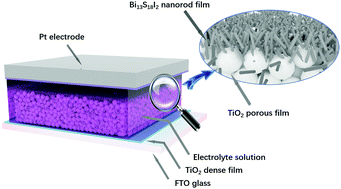Bismuth chalcogenide iodides Bi13S18I2 and BiSI: solvothermal synthesis, photoelectric behavior, and photovoltaic performance†
Abstract
Bismuth chalcogenide iodides Bi13S18I2 and BiSI were synthesized and characterized as light absorbers for solar cells. The formations of Bi13S18I2 and BiSI can be controlled via a facile solvothermal process. BiSI is formed under low S/Bi mole ratio conditions but it easily converts to Bi13S18I2 under high S/Bi mole ratio conditions. Bi13S18I2 is an n-type semiconductor with a narrow bandgap of 0.75 eV and exhibits a strong light absorbance in the wide wavelength range from UV to NIR, making it a promising light absorber material for solar cells. A uniform B13S18I2 nanorod film was fabricated on a porous TiO2 electrode via a modified solvothermal process for a photovoltaic study. A Bi13S18I2-based solar cell has demonstrated a power conversion efficiency of 0.85% for the first time, revealing the potential of Bi13S18I2 as a new type of light absorber material for solar cells which can be fabricated via a low-cost solution process.



 Please wait while we load your content...
Please wait while we load your content...